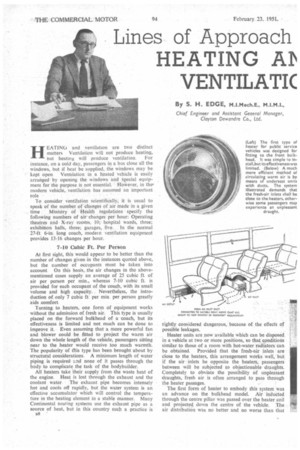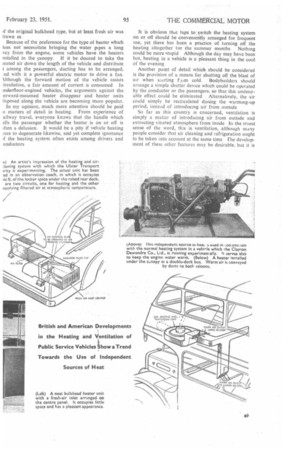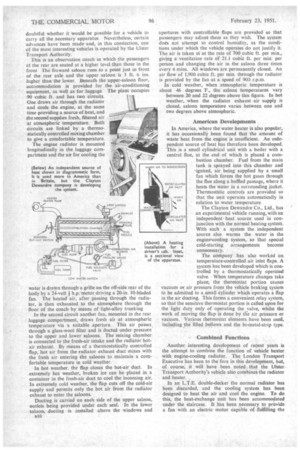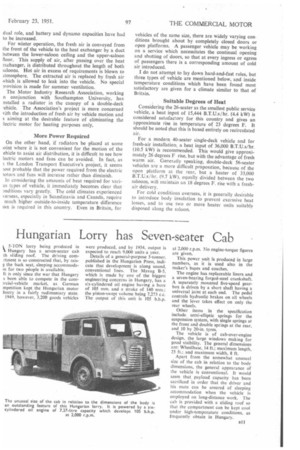• Lines of Approach HEATING AD VENTILATIC
Page 42

Page 43

Page 44

Page 45

If you've noticed an error in this article please click here to report it so we can fix it.
By S. H. EDGE, M.i.Mech.E., M.I.M.i., 11 EATING and ventilation are two distinct matters Ventilation will not produce heating, but heating will produce ventilation. For instance, on a cold day, passengers in a bus close all the windows, but if heat be supplied, the windows may be
kept open Ventilation in a heated vehicle is easily arranged by opening the windows and special equipment for the purpose is not essential. However, in themodern vehicle, ventilation has assumed an important role To consider ventilation scientifically, it is usual to speak of the number of changes of air made in a given time Ministry of Health regulations specify the following numbers of air changes per hour: Operating theatres and X-ray rooms. 10; hospital wards, three; exhibition halls, three; garages, five. In the normal 27-ft 6-in, tong coach, modern ventilation equipment provides 13-16 changes per hour. '
7-10 Cubic Ft. Per Person At first sight, this would appear to be better than the number of changes given .in the instances quoted above, but the number of occupants must he taken into account. On this basis, .the air changes in the above. mentioned cases supply an average of 25 cubic ft. of air per person per min., whereas 7-10 cubic ft. is provided for each occupant of the coach, with its small volume and high capacity. Nevertheless, the introduction of only 7 cubic ft. per min. per person greatly aids comfort.
Turning to heaters, one form of equipment works without the admission of fresh air. This type is usually placed on the forward bulkhead of a coach, but its effectiveness is limited and not much can be done to improve it. Even assuming that a more powerful fan and blower could be fitted to project the warm air down the whole length of the vehicle, passengers sitting near to the heater would receive too much warmth. The popularity of this type has been brought about by structural considerations. A minimum length of water piping is required 1.nd none of it passes through the bodyto complicate the task of the bodybuilder.
All heaters take their supply from the waste heat of the engine. Heat is lost through the exhaust and the
coolant water The exhaust pipe becomes intensely hot and cools. off rapidly, but the water system is an effective accumulator which will control the temperature in the heating element in a stable manner. Many Continental nearing systems use the exhaust pipe as a source of heat, but in this country such a practice is
rightly considered dangerous, because of the effects of possible leakages.
Heater units are now available which can be disposed in a vehicle at two or more positions, so that conditions similar to those of a room with hot-water radiators can be obtained. Provided that the fresh-air inlets are close to the heaters, this arrangement works well, but if the air inlets be opposite the heaters, passengers between will be subjected to objectionable draughts. Completely to obviate the possibility of unpleasant draughts, fresh air is often arranged to pass through the heater passages.
The first form of heater to embody this system was an advance on the bulkhead model. Air inducted through the centre pillar was passed over the heater coil and projected, down the centre of the vehicle. The air distribution was no better and no worse than that
if the original bulkhead type, but at least fresh air was Irawn in Because of the preference for the type of heater which toes not necessitate bringing the water pipes a long vay from the engine, some vehicles have the heaters nstalled in the canopy. If it be desired to take the leated air down the length of the vehicle and distribute t among the passengers, ducting has to be arranged, nd with it a powerful electric motor to drive a fan. klthough the forward motion of the vehicle assists irculation, a fair .amount of current is consumed In inderfloor-engined vehicles, the arguments against the orward-mounted heater disappear and heater units lisposed along the vehicle are becoming more popular.
In my opinion, much more attention should be paid o matters of detail in heating. From experience of ailway travel, everyone kaaws that the handle which ells the passenger whether the heater is on or off is ,ften a delusion. It would be a pity if vehicle heating vere to degenerate likewise, and yet complete ignorance the heating system often exists among drivers and onductors It is obvious that taps to switchthe heating system on or _off should be conveniently arranged for frequent use, yet there has been a practice of turning off the heating altogether for the summer months Nothing could be more stupid Although the day may have been hot, heating in a vehicle is a pleasant thing in the cool of the evening Another point of detail which should be considered is the provision of a means for shutting off the blast of air when starting f:um cold. Bodybuilders should arrange a simple shutter device which could be operated by the conductor or the passengers, so that this undesir able effect could be eliminated Alternatively, the air could simply be recirculated d.ur.ing the warming-up period, instead of introducing air' from outside So far as this country is concerned, ventilation is simply a matter of introducing air from outside and extracting vitiated atmosphere from inside In the truest sense of the word, this is ventilation, although many people consider that air cleaning and refrigeration ought to be taken into account at the same time The development of these other features may be desirable, but it is doubtful whether it would be possible for a vehicle to carry all the necessary apparatus Nevertheless, certain advances have been made and, in this connection, one of the most interesting vehicles is operated by the Ulster Transport Authority.
This is an observation coach in which the passengers at the rear are seated at a higher level than those in the front The foiward saloon runs to a point just in front of the rear axle and the upper saloon is 3 ft 6 ins. higher than the lower. Beneath the upper-saloon floor, accommodation is provided for the air-conditioning equipment, as well as for luggage. The plant occupies 90 cubic ft. and has two circuits. One draws air through the radiator and cools the engine, at the same time providing a source of heat, and the second supplies fresh, filtered air at atmospheric temperature. Both circuits are linked by a thermostatically controlled mixing chamber to give a comfortable temperature.
The engine radiator is mounted longitudinally in the luggage compartment and the air for cooling the
water is drawn through a grille on the off-side rear of the body by a 24-volt h.p. motor, driving a 20-in. 10-bladed fan. The heated air, after passing through the radiator, is then exhausted to the atmosphere through the floor of the coach by means of light-alloy trunking In the second circuit another fan, mounted in the rear luggage compartment, draws fresh air at atmospheric tempe:aature via a suitable aperture. This air passes• through a glass-wool filter and is ducted under pressure to the upper and lower saloons. The mixing chamber is connected to the fresh-air intake and the radiator hotair exhaust. By means of a thermostatically controlled flap, hot air from the radiator exhaust duct mixes with the fresh air entering the saloons to maintain a comfortable temperature in cold weather.
In hot weather, the flap closes the hot-air duct. In extremely hot weather, broken ice can be placed in a container in the fresh-air duct to cool the incoming air. In extremely cold weather, the flap cuts off the cold-air supply and permits only the hot air from the radiator exhaust to enter the saloons.
Ducting is carried on each side of the upper saloon, outlets being provided under each seat. In the lower saloon, ducting is installed above the windows and at 0
apertures with controllable flaps are provided so that passengers may adjust them as they wish. The system does not attempt to control humidity, as the conditions under which the vehicle operates do not justify it. The air is taken in at the rate of 700 cubic ft. per min., giving a ventilation rate of 21.1 cubic ft. per min. per person and changing the air in the saloon three times every 4 mins. All windows are permanently closed. An air flow of 1,900 cubic ft. per min. through the radiator is provided by the fan at a speed of 900 r.p.m.
In cold weather, when atmospheric temperature is about 46 degrees F., the saloon temperatures vary 'between 20 and 22 degrees above this figure. In hot weather, when the radiator exhaust air supply is closed, saloon temperature varies between one and two degrees above atmospheric.
American Developments
In America, where the water heater is also popular, it has occasiona4 been found that the amount of waste heat from the engine is insufficient. An inde pendent source of heat has therefore been developed.
This is a small cylindrical unit with a boiler with a central flue, at the end of which is placed a combustion chamber. Fuel from the main tank is sprayed into this chamber and -ignited, air being supplied by a small fan which forces the hot gases through the flue along a baffled passage, where it heats the water in a surrounding jacket. Thermostatic controls are provided so that the unit operates automatically in relation to water temperature.
RECIRCULATED AIR INLET , WARM
AIR
The Clayton Dewandre Co., Ltd., has an experimental vehicle running, with an independent heat source used in conjunction with the normal heating system. With such a system the independent source also warms the water in the engine.cooling system, so that special cold-starting arrangements become unnecessary.
The company has also worked on temperature-controlled air inlet flaps. A • system has been developed which is controlled by a thermostatically operated valve When temperature changes take place, the thermostat portion causes vacuum or air pressure from the vehicle braking system to be admitted to a small cylinder which operates a flap in the air ducting. This forms a convenient relay system, so that the sensitive thermostat portion is called upon for the light duty only of operating the valve, whilst the work of moving the flap is done by Se air pressure or vacuum. Various thermostat elements have been used, including the filled bellows and the bi-metal-strip type.
Combined Functions Another interesting development of recent years is the attempt to combine the function of vehicle heater with engine-cooling radiator. The London Transport Executive has been to the fore in this development, but, of course, it will have been noted that the UlsterTransport Authority's vehicle also combines the radiator and heater.
In an L.T.E. double-decker the normal radiator has been discarded, and the cooling system has been designed to heat the air and cool the engine. To do this, the heat-exchange unit has been accommodated under the staircase. It has been necessary to provide a fan with an electric motor capable of fulfilling the
dual role, and battery and dynamo capacities have had to be increased.
For winter operation, the fresh air is conveyed from the front of the vehicle to the heat exchanger by a duct between the lower-saloon ceiling and the upper-saloon floor. This supply of air, after passing over the heat exchanger, is distributed throughout the length of both ialoons. Hot air in excess of requirements is blown to itmosphere. The extracted air is replaced by fresh air ,vhich is allowed to leak into the vehicle. No special )rovision is made for summer ventilation.
The Motor Industry Research Association, working n conjunction with Southampton University, has nstalled a radiator in the canopy of a double-deck 'chicle. The Association's project is more concerned vith the introduction of fresh air by vehicle motion and s aiming at the desirable feature of eliminating the lectric motor for heating purposes only.
More Power Required On the other hand, if radiators be placed at some ,oint where it is not convenient for the motion of the chicle to assist air distribution, it is difficult to see how lectric motors and fans can be avoided. In fact, as the London Transport Executive's project, it seems lost probable that the power required from the electric iotors and fans will increase rather than diminish.
In considering the amounts of heat required for vanus types of vehicle, it immediately becomes clear that )nditions vary greatly. The cold climates experienced verseas, especially in Scandinavia and Canada, require much higher outside-to-inside temperature difference an is required in this country. Even in Britain, for vehicles of the same size, there are widely varying con. ditions brought about by completely closed doors or open platforms. A passenger vehicle may be working on a service which necessitates the continual opening and shutting of doors, so that at every ingress or egress of passengers there is a corresponding amount of cold air introduced.
I do not attempt to lay down hard-and-fast rules, but three types of vehicle are mentioned below, and inside temperature conditions which have been found most satisfactory are given for a climate similar to that of Britain.
Suitable Degrees of Heat
Considering the 26-seater as the smallest public service vehicle, a heat input of 15,444 B.T.U.s/hr. (4.4 kW) is considered satisfactory for this country and gives an approximate rise in temperatnre of 23 degrees F. It should be noted that this is based entirely on recirculated air.
For a modern 40-seater single-deck vehicle and for fresh-air installation, a heat input of 36,000 B.T.U.s/hr. (10.5 kW) is recommended. This would give approximately 26 degrees F rise, but with the advantage of fresh warm air, Generally speaking, double-deck 56-seater vehicles are a more difficult proposition, because of the open platform at the rear, but a heater of 33,000 B.T.U.s/ hr. (9.7 kW), equally divided between the two saloons, will maintain an 18 degrees F. rise with a freshair delivery.
For cold conditions overseas, it is generally desirable to introduce body insulation to prevent excessive heat losses, and to use two or more heater units suitably disposed along the saloon.




















































































